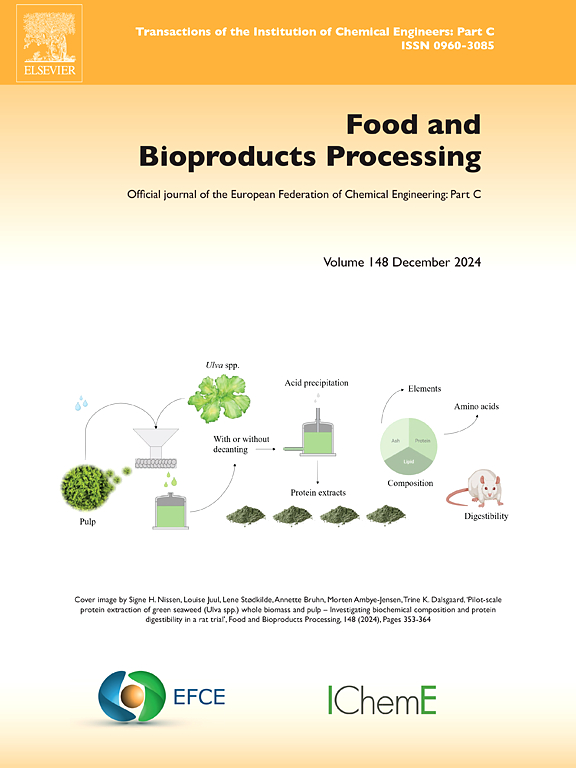无化学萃取法提取地中海卤黄发酵产生的多羟基烷烃酸酯
IF 3.4
2区 农林科学
Q2 BIOTECHNOLOGY & APPLIED MICROBIOLOGY
引用次数: 0
摘要
聚羟基烷酸酯(PHAs)是一种可生物降解的聚合物,具有良好的机械和热性能,是传统塑料的可持续替代品。尽管PHA具有优势,但PHA生产和下游分离纯化的原料成本高,阻碍了PHA的广泛采用。本研究展示了地中海Haloferax以甘油废料为低成本底物生产聚(3-羟基丁酸酯-co-3-羟基戊酸酯)(PHBV)的中试规模,然后使用高压均质(HPH)提取和纯化PHA。结果表明,在非无菌条件下,使用甘油废液的细胞质量为5.7 g/L,细胞中PHBV含量为38 %。以hph为基础的下游工艺,PHBV回收率为85 %,纯度为90 %。HPH萃取没有改变天然PHBV的热性能,但HPH压力增加导致分子量降低24.6% %。这项研究强调了废甘油作为可行原料的潜力,并强调了下游加工条件如何影响PHA特性的理解。优化这些参数对改善PHAs的提取工艺,提高PHAs的应用价值至关重要。本文章由计算机程序翻译,如有差异,请以英文原文为准。
Chemical free extraction of polyhydroxyalkanoates produced from pilot-scale Haloferax mediterranei fermentation of glycerol waste
Polyhydroxyalkanoates (PHAs) are biodegradable polymers with great mechanical and thermal properties, offering a sustainable alternative to conventional plastics. Despite their advantages, the widespread adoption of PHAs is hindered by the high cost of feedstock in PHA production and downstream separation and purification. This study demonstrates pilot-scale production of poly(3-hydroxybutyrate-co-3-hydroxyvalerate) (PHBV) by Haloferax mediterranei using glycerol waste as a low-cost substrate, followed by PHA extraction and purification using high-pressure homogenization (HPH). The results show that under nonsterile conditions, using glycerol waste yield 5.7 g/L cell mass with 38 % PHBV content in cells. HPH-based downstream processing achieved a PHBV recovery efficiency of 85 % and a purity of 90 %. HPH extraction did not alter the thermal properties of native PHBV, except that increasing HPH pressure led to a reduction in molecular weight of 24.6 %. This study highlights the potential of waste glycerol as a viable feedstock and underlines the understanding of how downstream processing conditions influence PHA properties. Optimizing these parameters is crucial to improving the extraction process and enhancing the application value of PHAs.
求助全文
通过发布文献求助,成功后即可免费获取论文全文。
去求助
来源期刊

Food and Bioproducts Processing
工程技术-工程:化工
CiteScore
9.70
自引率
4.30%
发文量
115
审稿时长
24 days
期刊介绍:
Official Journal of the European Federation of Chemical Engineering:
Part C
FBP aims to be the principal international journal for publication of high quality, original papers in the branches of engineering and science dedicated to the safe processing of biological products. It is the only journal to exploit the synergy between biotechnology, bioprocessing and food engineering.
Papers showing how research results can be used in engineering design, and accounts of experimental or theoretical research work bringing new perspectives to established principles, highlighting unsolved problems or indicating directions for future research, are particularly welcome. Contributions that deal with new developments in equipment or processes and that can be given quantitative expression are encouraged. The journal is especially interested in papers that extend the boundaries of food and bioproducts processing.
The journal has a strong emphasis on the interface between engineering and food or bioproducts. Papers that are not likely to be published are those:
• Primarily concerned with food formulation
• That use experimental design techniques to obtain response surfaces but gain little insight from them
• That are empirical and ignore established mechanistic models, e.g., empirical drying curves
• That are primarily concerned about sensory evaluation and colour
• Concern the extraction, encapsulation and/or antioxidant activity of a specific biological material without providing insight that could be applied to a similar but different material,
• Containing only chemical analyses of biological materials.
 求助内容:
求助内容: 应助结果提醒方式:
应助结果提醒方式:


